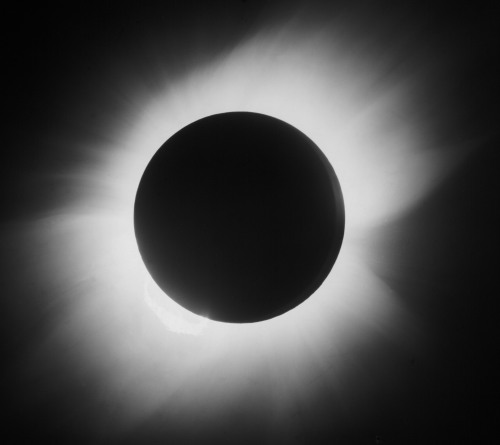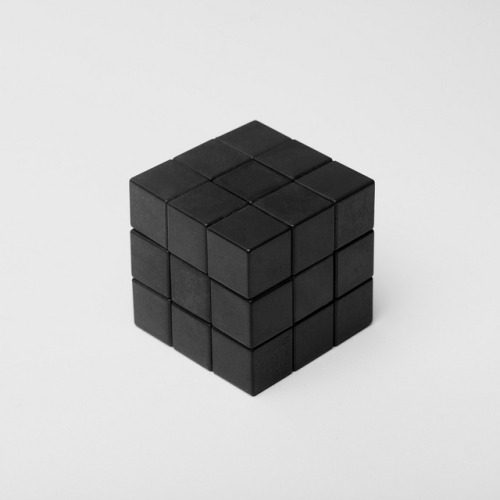The Full Rotation Of The Moon As Seen By NASA’s Lunar Reconnaissance Orbiter.
The full rotation of the Moon as seen by NASA’s Lunar Reconnaissance Orbiter.
More Posts from Hannahhaifisch and Others

Our Galaxy’s Magnetic Field from Planck https://go.nasa.gov/2quwDLs


Hubble Image Captures Collision of Two Spiral Galaxies
http://www.sci-news.com/astronomy/hubble-collision-two-spiral-galaxies-04839.html

Photograph of the May 1919 solar eclipse captured by Arthur Eddington, which proved Einstein’s theory of general relativity.
Credit: SSPL/Getty Images


The Meteor Shower Of 1833








“Sketching Fractals” by Music: Fractals are a treat for your eyes, but what about your ears?
Fractals are geometric constructs that exhibit similar or identical characteristics at every level of magnitude. They provide new tools for geometers to describe objects of extreme intricacy, such as clouds, ferns, snowflakes, mountain ranges, stock-market fluctuations, the human circulatory and nervous system, etc.. The geometry of Fractals brings us a new appreciation for the natural world and the beauty of mathematics. Some of the most popular examples are: The Sierpinski triangle and the Von Koch snowflake.
Fractals are a treat for your eyes, but what about your ears?. Dmitry Kormann, a composer/keyboardist from São Paulo, Brazil, explains how he brings fractal-like patterns to the very structure of his music, to obtain beautiful results. See more at: [http://plus.maths.org/issue55/features/Kormann]
Images: Snow winter at Datspiff on Tumblr & Snowflakes and snow crystals on Flickr.
References:
[Fractal Dimensions of Geometric Objects on Fractalfoundation.org]
[http://en.wikipedia.org/wiki/Fractal]

0009







Double triangle sawtooth by Miguel Angel Blanco Muñoz. I have liked how time seemed to slow down, folding the grid.








Hubble Views The Final Frontier For Dark Matter
“This phenomenon of gravitational lensing stretches galaxies into streaks and arcs, magnifying them, and creating multiple images. It also enables us to reconstruct the mass distribution of the cluster, revealing that it’s mostly due to dark matter.”
When you look out at the distant Universe, you can see all sorts of things: stars, galaxies, clusters of galaxies, going as far back into the distant past as our telescopes can image. But where you have the greatest concentrations of mass, an extreme phenomenon emerges: that of gravitational lensing. Any foreground objects lying behind that mass will have their light stretched, magnified and distorted by the intervening matter. Recently, as part of the Hubble Frontier Fields program, the telescope followed-up on galaxy cluster Abell 370, and revealed the most spectacular gravitational lensing signal ever seen in a galaxy cluster. Most importantly, it provides some very strong evidence not only for dark matter’s existence, but for its presence distinct from any galaxies at all.
Come get the full story in images, videos, and no more than 200 words on this edition of Mostly Mute Monday!
-
 bumblebeady reblogged this · 3 weeks ago
bumblebeady reblogged this · 3 weeks ago -
 rudewolfboi reblogged this · 3 weeks ago
rudewolfboi reblogged this · 3 weeks ago -
 everenow liked this · 3 weeks ago
everenow liked this · 3 weeks ago -
 juiciodeparis liked this · 3 weeks ago
juiciodeparis liked this · 3 weeks ago -
 feinefee1 liked this · 3 weeks ago
feinefee1 liked this · 3 weeks ago -
 gtu7 liked this · 3 weeks ago
gtu7 liked this · 3 weeks ago -
 doodwordz liked this · 3 weeks ago
doodwordz liked this · 3 weeks ago -
 kansasraptor liked this · 3 weeks ago
kansasraptor liked this · 3 weeks ago -
 swimmingnachopanda reblogged this · 3 weeks ago
swimmingnachopanda reblogged this · 3 weeks ago -
 swimmingnachopanda liked this · 3 weeks ago
swimmingnachopanda liked this · 3 weeks ago -
 cownslu reblogged this · 3 weeks ago
cownslu reblogged this · 3 weeks ago -
 cownslu liked this · 3 weeks ago
cownslu liked this · 3 weeks ago -
 consupriser reblogged this · 3 weeks ago
consupriser reblogged this · 3 weeks ago -
 consupriser liked this · 3 weeks ago
consupriser liked this · 3 weeks ago -
 transparentcloudgentlemen liked this · 4 weeks ago
transparentcloudgentlemen liked this · 4 weeks ago -
 mcgoobers liked this · 4 weeks ago
mcgoobers liked this · 4 weeks ago -
 heruniversitydonutneck liked this · 4 weeks ago
heruniversitydonutneck liked this · 4 weeks ago -
 firstsciencepoemcop liked this · 4 weeks ago
firstsciencepoemcop liked this · 4 weeks ago -
 whzzitt reblogged this · 4 weeks ago
whzzitt reblogged this · 4 weeks ago -
 8491a reblogged this · 1 month ago
8491a reblogged this · 1 month ago -
 8491a liked this · 1 month ago
8491a liked this · 1 month ago -
 miguelleon925607 liked this · 1 month ago
miguelleon925607 liked this · 1 month ago -
 dicktrickle8312 reblogged this · 1 month ago
dicktrickle8312 reblogged this · 1 month ago -
 yourspeeddreamer reblogged this · 1 month ago
yourspeeddreamer reblogged this · 1 month ago -
 yourspeeddreamer liked this · 1 month ago
yourspeeddreamer liked this · 1 month ago -
 dec17neverhappened liked this · 1 month ago
dec17neverhappened liked this · 1 month ago -
 scanjunky66 liked this · 1 month ago
scanjunky66 liked this · 1 month ago -
 badwayz99 liked this · 1 month ago
badwayz99 liked this · 1 month ago -
 badwayz99 reblogged this · 1 month ago
badwayz99 reblogged this · 1 month ago -
 deepestmentalitypolice liked this · 1 month ago
deepestmentalitypolice liked this · 1 month ago -
 b8o0s4s reblogged this · 1 month ago
b8o0s4s reblogged this · 1 month ago -
 b8o0s4s liked this · 1 month ago
b8o0s4s liked this · 1 month ago -
 toppr reblogged this · 1 month ago
toppr reblogged this · 1 month ago -
 fireandlace911 reblogged this · 1 month ago
fireandlace911 reblogged this · 1 month ago -
 iagoinwaiting liked this · 1 month ago
iagoinwaiting liked this · 1 month ago -
 americansinner reblogged this · 1 month ago
americansinner reblogged this · 1 month ago -
 sacotatrs reblogged this · 1 month ago
sacotatrs reblogged this · 1 month ago -
 thehambuger reblogged this · 1 month ago
thehambuger reblogged this · 1 month ago -
 blackcrane4 liked this · 1 month ago
blackcrane4 liked this · 1 month ago -
 georgiagentleman reblogged this · 1 month ago
georgiagentleman reblogged this · 1 month ago -
 jacksmulebarn liked this · 1 month ago
jacksmulebarn liked this · 1 month ago -
 tfinney5 liked this · 1 month ago
tfinney5 liked this · 1 month ago -
 rakinino liked this · 1 month ago
rakinino liked this · 1 month ago -
 gadawg-404 reblogged this · 1 month ago
gadawg-404 reblogged this · 1 month ago -
 aleksandr-tula-rus liked this · 1 month ago
aleksandr-tula-rus liked this · 1 month ago -
 strutzredux2 reblogged this · 1 month ago
strutzredux2 reblogged this · 1 month ago